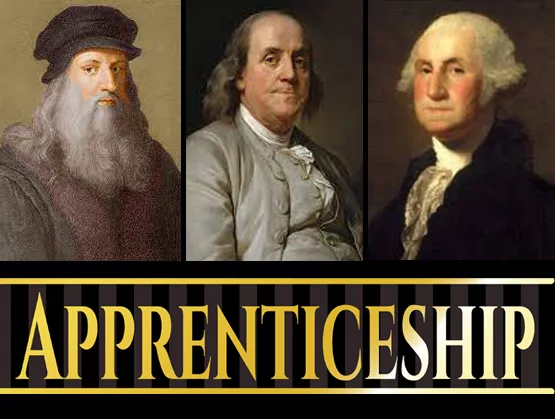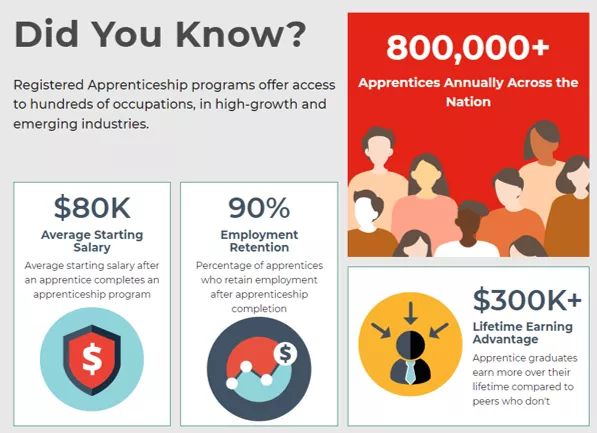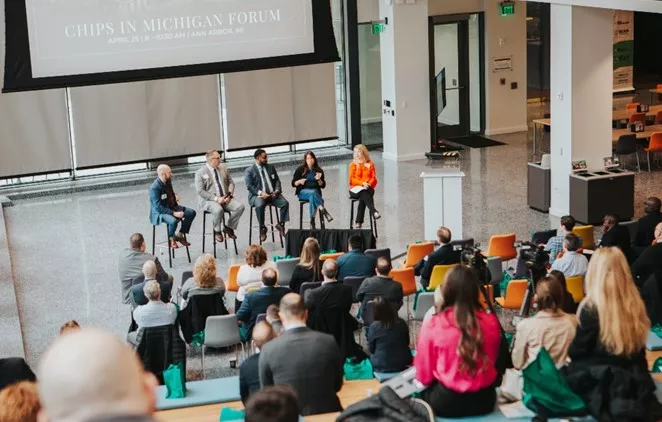
What do George Washington, Leonardo da Vinci, and Benjamin Franklin all have in common? Besides being influencers of their times, they were supported in a specialized career pathway that led them to tremendous success: they were all apprentices.
To fulfill its promise to grow to $1 trillion as soon as 2030, the semiconductor industry will need an estimated 1 million new workers including fab operators, engineers and technicians. Addressing this challenge will take a whole-of-industry approach and significant investments like the CHIPS Act and similar programs worldwide. It will also require a fundamental rethinking of employer approaches to attracting, recruiting, and retaining a far more diverse workforce that represents the widest possible range of perspectives, backgrounds, and ideas so the industry can continue to innovate, problem solve, and thrive.
There are many strategies to growing a diverse workforce, but one rises to the top as the gold standard for both employers and employees: Registered Apprenticeships. Although these programs have changed significantly since da Vinci’s time, his stint as an apprentice and then later as a master to other apprentices not only allowed him to create works of art that benefit us to this day; he also changed the world of art by sharing his expertise with those who followed. George Washington and Ben Franklin did not primarily continue in their apprentice trades – Washington studied as a surveyor, Franklin as a printer – but the skills and connections they learned undoubtedly supported them on their career pathways.

Modern apprenticeships offer the same benefits, and so much more. As described by Apprenticeship USA, “Apprenticeship is an industry-driven, high-quality career pathway where employers can develop and prepare their future workforce, and individuals can obtain paid work experience, classroom instruction, and a portable, nationally-recognized credential.” Apprenticeships allow companies to customize training so workers can develop the knowledge, skills, and abilities the organizations need. In addition, Registered Apprenticeship Programs (RAPs) help improve productivity, reduce turnover, increase retention, strengthen diversity, and boost the bottom line. For workers, apprenticeships are a tremendous opportunity to earn while they learn; to access support services and systems that help ensure training completion; and to enjoy higher starting salaries and lifetime earnings.
Robust resources are available for both employers and workers interested in apprenticeships. Many regions offer apprenticeship intermediaries that help companies navigate apprenticeship requirements and support program development. There are also federal and state programs, such as the Workforce Innovation and Opportunity Act (WIOA), that provide funding for support services for apprentices, such as transportation vouchers, access to professional clothing, childcare, and more.

RAPs are a well-supported and proven way to increase, diversify, and strengthen a workforce while providing opportunities for lucrative jobs and career growth to people and communities who might not otherwise have access to them.
The National Institute of Standards and Technology (NIST) agrees. In NIST’s Workforce Development Planning Guide for CHIPS incentives applicants, RAPs are called out as an important strategy that companies are highly encouraged to consider. Many states have also made major commitments to building these programs, including Michigan, Colorado, Arizona, New York and Massachusetts. California Governor Gavin Newsom has put a true stake in the ground for these programs, committing to serving 500,000 apprentices by 2029.
Adele Burnes is Deputy Chief of the California Division of Apprenticeship Standards (DAS), a state agency that consults with employers to develop a skilled workforce with viable career pathways to increase productivity and strengthen the economy. The DAS is working on multiple fronts to expand RAPs in California.
“Apprenticeships are an opportunity for companies to tap into a broader talent pool by creating a supported earn and learn pathway into a career in their organization,” Burnes said. “Many companies that are struggling to find and retain talent are finding that the apprenticeship mechanism is a great way to grow their talent pool, increase productivity, and retain workers. There are a lot of bright, hardworking, resourceful people out there who cannot afford to only study and not work, and an apprenticeship creates a pathway into a career for those folks that gives them a supported entry-level role, while allowing them to take classes and upskill specifically for that job.”
Burnes, and the DAS, see apprenticeships as a win-win for companies and a diverse set of talent.

The SEMI Foundation is also investing in apprenticeships. The SEMI Career and Apprenticeship Network, or SCAN, offers customized training programs for employers and workers to help broaden and diversify the semiconductor industry workforce and assist companies in developing talent. SCAN, initially designed to support registered apprenticeships in the chip industry, also supports other kinds of training, including boot camps and training certifications.
When the SEMI Foundation first set out to build a RAP for the chip industry in 2021, we were met with significant resistance to the apprenticeship model. At the time, we were recruiting companies to sign on to our application to the Biden Administration’s Good Jobs Challenge.
“It just wasn’t a model that was familiar to many of our members,” said Shari Liss, Executive Director of the SEMI Foundation. “Although a few companies employed apprentices, for the most part, the industry in general in the U.S. did not feel ready to embrace this alternative pathway. We spent countless hours with executives across the country talking about the benefits of the program and how the model has been so successful in other industries.”
Since then, there has been a sea change in the industry. RAP investments have increased at the state level and the CHIPS Act has elevated awareness of the RAP model. With an already significant talent shortage and tens of thousands workers required for the as many as 13 new fabs planned in the U.S. in the coming years, these alternative pathways are becoming far more appealing to SEMI member companies. And the SEMI Foundation can help.

Through SCAN, we have launched new registered apprenticeship programs in Michigan and California, with the support and partnership of state agencies. In California, through funding from the California Apprenticeship Initiative, we are building RAPs for Applied Materials, Enablence, Infinera, and Lam Research, and several other companies are considering the programs. Our partners at the Michigan Economic Development Corporation are supporting our work to build RAPs for Calumet Electronics and PSI Repair Services, Inc.
California and Michigan are in very different stages of development in their microelectronics workforce and employer ecosystems, but SCAN is adaptable to any region. In Michigan, for example, much of the work has been focused on building partnerships. This past April, the SEMI Foundation held a CHIPS in Michigan forum, hosted by KLA. The event brought together industry leaders, workforce and economic development agencies, education providers, and community-based organizations to discuss developing the semiconductor industry in Michigan through apprenticeships and the opportunities provided by the CHIPS Act.

A panel conversation during the CHIPS in Michigan event at KLA
Many other companies and regions have expressed interest in creating RAPs, and the SEMI Foundation intends to grow SCAN wherever there is need and investment. We know that this model provides companies with the opportunity to grow and develop diverse talent sets and helps workers move into quality jobs in a rapidly expanding industry. The model has seen many changes since the time of da Vinci, Washington, and Franklin, but its capacity to change lives, communities, companies, and industry has only improved.
If you are interested in finding out more about apprenticeships or SCAN, please contact us at semifoundation@semi.org.
Michelle Williams-Vaden is deputy director of the SEMI Foundation.